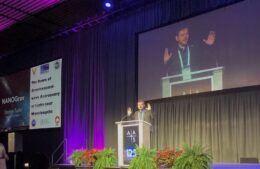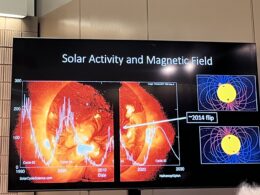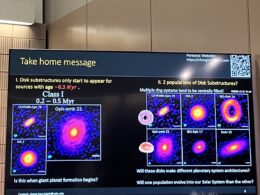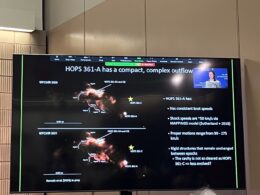Editor’s Note: This week we’re at the 243rd AAS meeting in New Orleans, LA. Along with a team of authors from Astrobites, we will be writing updates on selected events at the meeting and posting each day. Follow along here or at astrobites.com for daily summaries, or follow @astrobites.bsky.social on BlueSky for more coverage. The usual posting schedule for AAS Nova will resume on January 16th.
Table of Contents:
- Fred Kavli Plenary Lecture: NANOGrav: The Dawn of Gravitational-Wave Astronomy at Light-Year Wavelengths, Stephen Taylor (Vanderbilt University)
- Special Session: International Students and Researchers in Astronomy: Issues and a Path Forward
- Press Conference: Dust, Clouds & Darkness
- Helen B. Warner Prize Lecture: The PAH Revolution: Cold, Dark Carbon at the Earliest Stages of Star Formation, Brett McGuire (Massachusetts Institute of Technology)
- Press Conference: Stars, Protostars & More Clouds
- Helen B. Warner Prize Lecture: The Milky Way as a Cosmological Laboratory, Ana Bonaca (Carnegie Institution for Science)
- Plenary Lecture: The Rarity of Life in the Universe, Alan Lightman (Massachusetts Institute of Technology)
- LeRoy E. Doggett Prize Lecture: It All Began with Tebbutt! The Peripatetic Path from New Zealand to New Orleans, Wayne Orchiston
Fred Kavli Plenary Lecture: NANOGrav: The Dawn of Gravitational-Wave Astronomy at Light-Year Wavelengths, Stephen Taylor (Vanderbilt University) (by William Lamb)
Disclaimer: Steve Taylor is my PhD advisor, and I am also a NANOGraver. Seeing him on stage as the Kavli Plenary Lecturer was inspirational and entertaining for me and his other PhDs who were sat close to the front of the room, watching him present on our work as a research group at Vanderbilt University and representing the NANOGrav collaboration. We were kicking ourselves; we should’ve brought some fun signs…The plenary began by acknowledging the early start to the day and jumping straight into the results from the North American Nanohertz Observatory for Gravitational Waves (NANOGrav). In June, in coordination with the European Pulsar Timing Array, the Indian Pulsar Timing Array, the Parkes Pulsar Timing Array, and the Chinese Pulsar Timing Array, we independently published strong evidence for a nanohertz-frequency gravitational wave background using pulsar timing arrays. He built up the talk by describing the gravitational wave spectrum, how pulsar timing arrays detect the background, and the likely astrophysical sources that create the background. To finish, Taylor explored the new science that should result from pulsar timing arrays, from probing supermassive black hole binaries and detecting their electromagnetic counterparts, to constraining “new physics” models that are generating a lot of excitement in the high-energy physics field. I can tell you: it is certainly a very exciting time for NANOGrav.
Special Session: International Students and Researchers in Astronomy: Issues and a Path Forward (by William Lamb)
For the first time at an AAS meeting, a session was dedicated to discuss the issues faced by international researchers and students that work and study in the US. The intent was to understand what these issues are and how AAS can help to tackle these issues. The session opened with Arpita Roy, a Program Scientist at Schmidt Futures. She shared her story about moving to the US to study astrophysics at Franklin & Marshall College before getting her PhD at Pennsylvania State University, where she worked on exoplanets with instruments from around the world. She reminds us that “astronomy is a global endeavour, but resources can be highly localised.” She remarked how international researcher issues are often framed in the context of logistics — what do they need to get to the US — but we often forget the value they bring to US research, and we should be focusing on that more. “It’s hard to work on your science when as a human being, you are being disrespected.”
The second speaker was Óscar Chávez Ortiz, a 4th-year graduate student at the University of Texas at Austin. He spoke about navigating academia as someone with DACA (Deferred Action for Childhood Arrivals) status. Chávez Ortiz’s family migrated to the US when he was very young, leaving him without lawful status in the US. He didn’t consider higher education until the DACA program existed, which finally “allowed me access to my dream.” However, being a “dreamer” still comes with barriers, such as being unable to leave the US for international conferences and being unable to apply to most, if not all, Research Experience for Undergraduates (REU) programs because applicants require citizenship. The DACA act has been life-changing for Chavez, but he still faces barriers, such as the legal limbo faced by people with DACA status, in particular when a new government administration or state chooses to become hostile to them.
I (William Lamb) spoke about my experience of moving to the US in August 2020 — during the height of the COVID-19 pandemic. I shared stories about my challenge to find safe, affordable accommodation to quarantine while taking online classes when I first moved, and some of the complications that I encountered in my first few months in the US which were exacerbated by the pandemic. I argued that these problems weren’t because of COVID-19, but because of the systematic problems in the US immigration system that urgently need to be addressed.
Following these talks, we were joined by the Chair of the AAS Education Committee, Tania Anderson; AAS agent Rica Sirbaugh French of MiraCosta College; and the organisers of the session, Yaswant Devarakonda from the AAS and Fabio Pacucci from the Center for Astrophysics. During the panel discussion with the audience, I believe we identified some important work and changes that need to be implemented by the AAS. For example, there are a lot of resources to support international researchers out there, but access to those resources is difficult and a lot of those resources conflict with each other. Another issue is the divide between access to REU programs, PhD fellowships, and even grants for professors, between domestic and international researchers. We agreed that the AAS needs to support international researchers significantly more, especially those with DACA status. We were buoyed by the news that the AAS is taking these concerns seriously, and they are planning on establishing a committee to discuss the barriers faced by international researchers.
If you would like to kept in the loop about the AAS’s plans, email Yaswant Devarakonda, who is the John N. Bahcall Public Policy Fellow for the AAS. We also encourage you to show your support for an AAS committee for international students by emailing the AAS with your story.
Press Conference: Dust, Clouds & Darkness (by Briley Lewis)
The first press conference of AAS 243 was a fun mashup of different topics, all in some way related to one particular fundamental component of the cosmos: dust.
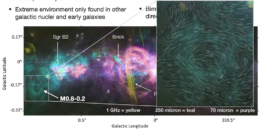
A diagram from Butterfield’s talk on the M0.8-0.2 polarized dust ring. This illustrates the location of the dust ring in the Milky Way, and visualizes the magnetic field lines within.
The session kicked off with Natalie Butterfield from the NRAO unveiling the discovery of a polarized ring of dust in the Milky Way’s center. This fascinating observation came from one of SOFIA’s legacy programs — FIREPLACE II, the 2nd Far-InfraRed Polarimetric Large Area CMZ Emission survey — that are keeping the flying telescope’s legacy alive even after its retirement. The extreme environment of the galactic center contains dense clouds, with magnetic fields of around 100 microgauss (very tiny compared to refrigerator magnets that may come to mind, but quite strong for interstellar space!).

A diagram from Butterfield’s talk showing how an expanding shell of a supernova remnant might sweep up magnetic field lines into the observed circular pattern.
In one specific ring, known as M0.8-0.2, they observed a curved magnetic field, tracing the ring of dust, with strengths around 1 milligauss — at least 10 times stronger than the background of the galactic center. They think this feature is actually a supernova remnant, with an expanding shell sweeping up material and compressing magnetic fields.
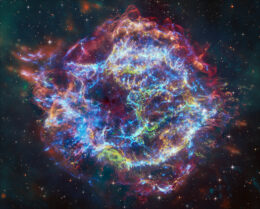
The new image of the Cassiopeia A supernova remnant including data from JWST. More details on the image are available in the Chandra press release. [X-ray: NASA/CXC/SAO; Optical: NASA/ESA/STScI; IR: NASA/ESA/CSA/STScI/Milisavljevic et al., NASA/JPL/CalTech; Image Processing: NASA/CXC/SAO/J. Schmidt and K. Arcand]
Jin Koda (Stony Brook University) and Amanda Lee (U. Mass Amherst) then presented a brand new data set from ALMA, looking at a region on the outskirts of the galaxy Messier 83 for molecular clouds, the sites of star formation. Using multiple telescopes and an international collaboration, they detected molecular clouds at the edges of a galaxy for the first time. Now, this leaves them with the question: how does the diffuse gas in the fringes of Messier 83 end up as molecular clouds?
Karen O’Neil from Green Bank Observatory announced another particularly exciting discovery: a new radio source that just might be the first primordial galaxy we’ve detected. This extremely faint source is about 83 megaparsecs away, with characteristics (like mass and rotation rates) of a pretty normal spiral galaxy. But, it’s extremely low brightness. It has a wealth of gas for star formation, yet not enough stars for it to shine in the sky — a dark galaxy seen before star formation really begins. It’s unclear why this galaxy is so unevolved, but they speculate that the gas may be too diffuse to start forming stars or there haven’t been any major interactions to spur star formation or tear the galaxy apart. Either way, this is likely one of a new class of objects, with hopefully many more to be found in upcoming radio surveys. “This is real,” said O’Neil. “We have spent many hundreds of hours of GBT [Green Bank Telescope] time to pin this down.”
To round out the session, Alison Coil (UCSD) presented another mysterious class of objects: odd radio circles, or ORCs (and yes, this acronym is bringing back how much I wish I saw Gimli in the exhibit hall yesterday!). ORCs were initially discovered in 2021, and they appear as large (~1 arcmin) rings in radio continuum centered on a galaxy, with physical sizes of hundreds of kiloparsecs across. Only about 11 are known, with a new one discovered about every two to three months. One particular ORC (ORC4, originally discovered by ASKAP) is huge, with a massive central galaxy and a radius of 200 kiloparsecs. Recently, astronomers imaged its host galaxy using the Keck Cosmic Web Imager, finding very strong OII emission lines, even far away from the galaxy — but not quite as far as the ORC. They determined that a burst of star formation in the galaxy’s past caused both the ORC and the OII ring. When the wind driven by the star formation burst shuts off, the forward shock (and its corresponding radio emission) continue propagating outwards, while the backwards shock with the OII falls back towards the galaxy. Perhaps ORCs aren’t so odd after all — or at least now we might know where they come from!

A diagram from Coil’s talk illustrating how the forward and reverse shocks from a star formation burst travel over time, creating the outer ORC and inner OII emission ring.
Helen B. Warner Prize Lecture: The PAH Revolution: Cold, Dark Carbon at the Earliest Stages of Star Formation, Brett McGuire (Massachusetts Institute of Technology) (by Ben Cassese)
Just before the first lunch break in New Orleans, the inhabitants of Grand Hall A were treated to a plenary session delivered by Brett McGuire of the Massachusetts Institute of Technology. McGuire’s day on the plenary stage was a long time coming: he had received the AAS’s Helen B. Warner Prize in 2022, but because of pandemic-related meeting disruptions he could not deliver his talk, “The PAH Revolution: Cold, Dark Carbon at the Earliest Stages of Star Formation,” until now.
McGuire began with an invocation of Douglas Adams (“In the beginning the Universe was created. This has made a lot of people very angry and been widely regarded as a bad move.”) and a broad outline of his mission. After explaining that the Big Bang left the universe with only the simplest elemental building blocks, he shared that “My job… is to figure out how you go from hydrogen and helium from the Big Bang to cats.” To do this, McGuire and his many collaborators search the coldest, densest, and darkest corners of the Milky Way for complex molecules, then try to explain where they all come from.McGuire’s primary tool in this endeavor is the Green Bank Telescope (GBT), and his favorite place to point it is the Taurus Molecular Cloud 1, a frigid but well-studied assemblage of gas and organics that he and collaborators suspected would provide fertile hunting grounds for new molecules. They were correct: in 2018, they found the second 5- or 6-membered ring species ever spotted in space, then went on to discover a laboratory stockroom’s worth of bizarre, complex molecules. Among these are the first four polycyclic aromatic hydrocarbons (PAHs) conclusively identified beyond the solar system, and many long, linear, and sometimes kinked chains of carbon.
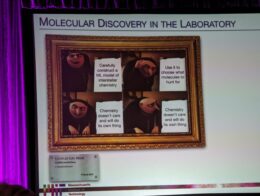
A slide to illustrate why laboratory experiments are necessary counterparts to theory and modeling. [B. McGuire]
Overall, McGuire’s talk was a lighthearted and joyful overview of recent advances in laboratory and data processing techniques that have uncovered dozens of new molecules in space. One left certain both that the recent past few years of cosmochemistry have been exciting, and that the next few will be even more so.
Press Conference: Stars, Protostars & More Clouds (by Mark Popinchalk)
At this conference there were four speakers, shining bright and talking about stars!
Asymmetric Gamma-ray Emission from the Quiet Sun
The first presenter was Elena Orlando (University of Trieste and Stanford University), telling us about asymmetry in our Sun seen in gamma rays. The Sun has a steady state of gamma radiation due to cosmic rays from beyond our solar system hitting it. This was first discovered in 2000. However, the Fermi mission has better sensitivity and angular resolution. The Sun crosses in front of Fermi daily, although to get good images one needs to integrate a few hundred days of data. Still, the researchers had Fermi data from 2008 to today to look through that covered the entirety of the solar 11-year activity cycle.
In the hundred-day window that included the peak of the solar activity, Orlando’s team noticed that there were more high-energy gamma rays from one pole and more low-energy gamma rays from the other! This peak in activity happens when the solar magnetic field flips. Orlando doesn’t yet have a full explanation, but this does suggest a crucial role of the magnetic field and opens up a link between astronomy, particle physics, and plasma physics.
A Colossal Star Erupts: Examining One of the Largest Stars in the Milky Way as It Fades From View
Narsireddy Anugu (CHARA Array; Georgia State University) introduced us all to RW Cephei, a huge hypergiant that has undergone a recent eruption! One of the largest stars in the galaxy, it reached an historical faintness in 2023. Anugu and collaborators wanted to learn more, but even with the star’s great size, it appears a million times smaller than our full Moon. Therefore they needed to use the CHARA array, the world’s largest optical interferometer. It combines six telescopes to make an effective diameter of 360 meters!

A slide from Narsireddy Anugu’s press conference showing the change in brightness of different regions of RW Cephei.
From these observations they were able to get an idea of the brightness of the object, and they saw that while there was one side that was fainter during the dimmest observation, it changed when the star started to brighten.
Anugu and collaborators proposed a similar mechanism to Betelgeuse’s great dimming event: a convective cell ejected a gas cloud, and as the cloud cools and forms dust it falls back onto the surface of the star, causing it to dim. These ejections might impact the mass of the star, which in turn might determine its ultimate fate!
Early Evolution of Planetary Disk Structures Seen for the First Time
Cheng-Han Hsieh (Yale University) changed the topic by releasing baby pictures of planetary systems — that is, some of the youngest planetary disk structures ever seen. Planets form in big dusty protoplanetary disks. Previous studies using ALMA targeted large luminous disks of more evolved disks with ages greater than 2 million years, but substructures in younger disks are hard to find.
The team used ALMA to survey nearly all the embedded protostars in seven young stellar populations. They grouped the substructures into two classes: those that seem to look like a donut (rings with a large central cavity), and those that look like filled buns (multiple ring systems with center filled). To be clear, this session was held directly after lunch, but this astrobiter certainly left hungry.
These disk substructures started to appear for sources that were at least 300,000 years old, which could perhaps be the start of giant planet evolution! But another question that arises is that if these two groups represent different kinds of disk populations, which population(s) can create solar systems like our own?
The Wondrous 3D World of Protostellar Shocks in NGC 2071
Finally Nicole Karnath (Space Science Institute) wanted to show us that young stars like to rock and roll. To do this, she and her collaborators looked at NGC 2071 IR, a star-forming region that hosts seven young stellar objects, including two protostars named HOPS-361 A and C. These are both intermediate-mass protostars, which will become stars bigger than our Sun. However, intermediate-mass stars aren’t as well studied. There is a need to assess the driving of turbulence in these regions, since if the stars are lashing out in their youth they could be lowering the overall star-formation efficiency in their surroundings. To do this, there needs to be an accurate map of the 3D motion of the gas the young stars are kicking off. This is difficult to obtain.
Fortunately, the team had the right tools: the Hubble Space Telescope (HST) and the SOFIA airplane-based telescope. They used an archival HST image that had the outflow from HOPS 361-A, and then another image from 2021. Just by comparing the two images you can see the gas moving!
HOPS 361-A has a compact, complex outflow of gas. The amount of gas kicked out seems to be the same between the 2009 and 2021 images, and the outflows are shooting off at hundreds of kilometers per second. Normally, it’s thought that most of the outflow material should be moving in a similar direction, but the outflows are going in different directions. It looks like this young star is very messy! Meanwhile HOPS 361-C has a knot of gas that is slowing down. Furthermore, it’s wobbling as it is throwing out gas, spinning over a loop every 2,000 years.
Finally, the data from SOFIA were included to show the full 3D movement, which wouldn’t have been possible without the infrared coverage (and it remains an open question of where the field can get similar data now that the mission has been ended.) Ultimately these two stars are causing very different outflows in NGC 2071 IR.
Helen B. Warner Prize Lecture: The Milky Way as a Cosmological Laboratory, Ana Bonaca (Carnegie Institution for Science) (by Kerry Hensley)
In the second Warner Prize lecture of the day, Ana Bonaca (Carnegie Institution for Science) introduced the study of stellar streams and how it can help us understand the nature of dark matter. Dark matter is a mysterious substance thought to make up 85% of the matter in the universe by mass. The nature of dark matter is encoded in its spatial distribution: hot dark matter produces a smooth distribution, while warm dark matter has a little structure, and cold dark matter clumps into structures and substructures down to low masses.

These images highlight the ghostly stellar streams looping around Messier 94 (left) and Messier 63 (right). Stellar streams are the remnants of globular clusters or dwarf galaxies. [Giuseppe Donatiello / Michele Trungati; Public Domain]
Using data from multiple sources, especially the Dark Energy Survey and the Gaia spacecraft, Bonaca and collaborators have discovered and characterized numerous stellar streams. The Milky Way contains about a hundred known stellar streams, mostly within 65,000 light-years, but Bonaca estimates that more than a hundred streams remain to be found — especially farther out. These far-out streams are enticing targets because they are farther from the gravitational disturbances created by the Milky Way’s spiral arms and central bar of stars, making the streams more sensitive to the influence of dark matter.
Of the known stellar streams, many have signs of past perturbations that could point to a close encounter with a dark matter subhalo. Modeling of one particular disrupted stellar stream suggested a fairly recent encounter with a massive (5 million solar masses or so) object, and Bonaca’s team will use the Hubble Space Telescope to study the stream further and narrow in on the location of the purported perturbing dark matter subhalo.
Bonaca identified three focus areas for future study: 1) Stellar streams with known progenitors (i.e., it is known which globular cluster or dwarf galaxy the stream came from), 2) stellar streams in the outer regions of the Milky Way, and 3) the population of stellar streams as a whole. Advancing each of these goals will require precise radial-velocity measurements, wide sky coverage, and the ability to study very faint targets. To that end, Bonaca and collaborators started the VIA project to build a spectrograph that meets their requirements, and the proposed project will involve a five-year survey that produces three million spectra. The Rubin Observatory’s Legacy Survey of Space and Time will also expand our understanding of stellar streams, helping us to study streams that are farther away and in much greater detail than is possible today.
Plenary Lecture: The Rarity of Life in the Universe, Alan Lightman (Massachusetts Institute of Technology) (by Yoni Brande)
It’s hard for most people to grasp the scales on which the universe exists. With a width of a hundred billion light-years, from 13.6 billion years in the past to a possibly infinite existence in the future, we are, as Carl Sagan put it, “on a mote of dust suspended in a sunbeam” in the universe. Alan Lightman’s plenary lecture today focused on putting ourselves into perspective, reflecting on our cosmic insignificance, as well as the immense significance of our unique position as observers of, and in, the universe.
Humans have been wondering about our place in the universe for our entire history as a species. Twenty thousand years ago, cave paintings in the Lascaux complex depicted the Pleiades star cluster, debates over differing cosmologies raged between geocentrism and heliocentrism, spiral nebulae and island universes, and the static and expanding universe. The development of modern astronomy, Lightman posits, is characterized by the continuing realization that we are not special in our place in the universe. We are, in fact, starstuff, made up of elements originally synthesized in the Big Bang and then in the explosive deaths of massive stars as supernovae.
In Lightman’s view, the vastness of the universe — with hundreds of billions of galaxies all made up of hundreds of billions of stars each — implies that life (and even intelligent life) must exist elsewhere in space and time. However, even if every habitable planet in the universe was teeming with life, the greatest fraction of living matter in the universe would be akin to a few grains of sand in the great Gobi desert.
Life must be rare in time as well as space, and perhaps even more concerning, Lightman says, is the fact that life has an end date. Life probably was able to arise after a billion years or so after the Big Bang, and in a hundred thousand billion years, the expansion of the universe will have stripped every galaxy away from every other galaxy, never to meet again. Lightman predicts this isolation will be the final nail in life’s coffin, lasting a mere 105 years out of a total potential universal lifetime of 1,084 years, from a Planck time after the Big Bang until the final proton decay, after which the universe will be in an eternal steady state. Life must be fleeting, Lightman says, but this gives it, and us, meaning. We must share a curiosity about and a consideration for our own isolation and mortality with everyone and everything that has ever or will ever live.
Lightman closed with a philosophical example: the “reverence for life” of Albert Schweitzer, German-French Nobel Laureate, physician, and philosopher. If Schweitzer’s biocentrism holds that there is a common kinship between all living beings on Earth, Lightman’s “cosmic biocentrism” extends this to all living things in the universe. “We few grains of sand in the desert are the only means by which the universe can consider itself. The cosmos will grind on for eternity long after we’re gone — cold and unobserved — but for these few powers of ten, we have been, we have seen, we have felt, we have lived.”
Plenary Lecture: LeRoy E. Doggett Prize Lecture: It All Began with Tebbutt! The Peripatetic Path from New Zealand to New Orleans, Wayne Orchiston (by Ali Crisp)
To wrap up Day 1 of AAS 243, we had the “first ever” evening plenary at the conference, given by Wayne Orchiston. His talk was primarily biographical, focusing on his own journey from a young boy inspired by the night sky to his talk tonight as the LeRoy E. Doggett Prize recipient for his contributions to the history of astronomy. A common theme throughout was the inspiration he took from the Australian astronomer John Tebbutt.
Orchiston explained that he first became interested in Tebbutt and historical astronomy in general as a teen, when his father’s job caused the family to move from Lincoln, New Zealand, to Sydney, Australia. There he discovered the Windsor Observatory — founded by Tebbutt — and the thousands of letters, observing logs, journals, and other documents of Tebbutt. He held onto this interest through several jobs: working as a radio telescope operator with CSIRO as he worked on his undergraduate degree, a postdoc in geology and human evolution in Melbourne, and director of the museum studies and astronomy programs at Victoria College.
During his time at Victoria College, the centennial of many of Tebbutt’s contributions, such as the discovery of the Great Comet of 1881 and the Australian bicentennial, fanned the flames of Orchiston’s interest in history of science research. He went on to explain how the papers he published about Tebbutt led him to new information about other astronomers or areas of astronomy, and to new job opportunities. Ultimately, through (by his count) 12 moves, Dr. Orchiston ended up living in Thailand with a remote position at the University of Science and Technology of China, where he hosts workshops with his wife/research collaborator, co-edits the open source Journal of Astronomical History and Heritage, and hosts a monthly virtual lecture series on the history of astronomy.
Orchiston closed his lecture by sharing amazement with where his career has taken him, describing himself as “a geography teacher who lost his way.” He stated that the Prize is one of his proudest achievements, and emphasized the main things he believes have led him to this point: opportunity, networking and role models, dedication, getting his work out there, flexibility, maintaining passion in his work, and the support of his wife.

